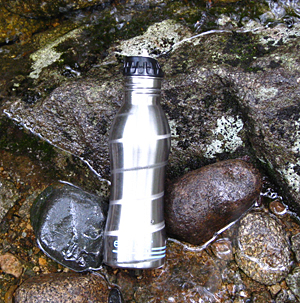
In-bottle water filters, like the Ech2o, offer simplicity and portability.
Water is heavy, yet I meet a lot of hikers and runners on the trail who feel they must carry all of the water that they need with them. I did the same thing before I learned how to use a water filter. But once you understand how easy it is to make natural water sources safe to drink, you'll find that you can hike farther, faster, and deeper into the wilderness than ever before by tapping the water sources around you as you need them.
Why Filter
Water filters are necessary to remove microscopic protozoa and bacteria that live in rivers, streams, and lakes and can make you sick if you ingest them. They work by drawing water through a matrix of very small holes that are smaller than these tiny organisms and only allow clean water to pass through. The filters themselves are made using glass fiber or activated carbon and can further improve the taste or appearance of water by filtering out minerals, metals, odors, and sediment. (Read "Backcountry Water Treatment" for more info.)
Filter Types
There are several types of water filters available today including bottle-based filters, filters with pumps, and gravity filters that use the weight of a suspended bag of water to push water through a filter. Each type of filter system has its pluses and minuses, but the advantage of bottle-based filters is their extreme portability and simplicity.
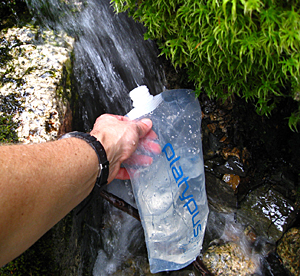
Prevent cross-contamination when you come in contact with unfiltered water by using hand sanitizer.
Proper Hygiene
With any water filter system proper hygiene is required whenever you come in contact with a natural water source, whether you drink from it or simply wet your hands. Good hygiene prevents what is known as cross-contamination, where a surface that is presumed clean is accidentally contaminated by water which has not been filtered. To prevent cross-contamination you can simply carry a 1-ounce bottle of isopropyl alcohol or Purell and thoroughly rub a small squeeze of it all over your hands whenever you come into contact with unfiltered water.
Bottle-Based Filters
All of the bottle-based filters reviewed below must be soaked with water before you use them and filters that contain activated carbon must be flushed several times to remove residual carbon dust. This makes it easier to draw water through them when you filter a suspect water source. After using your filter, flush it out with regular chlorinated tap water to reduce bacteria growth between hikes, just make sure that it has been pre-soaked and tested before each use.
All of these filters are sufficient to remove the protozoa and bacteria found in untreated water supplies throughout the United States and Canada, and I've used all of these filters in the backcountry with no ill effects. If you are traveling to countries with less developed sewage systems or want to protect yourself against viruses, I recommend augmenting these filters with chlorine dioxide tablets.
Ech2o Filtered Water Bottle * Trailspace Pick for Day Hiking * |
|||
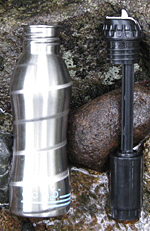 |
Specs: |
Pros: The integrated filter and bottle cap prevents dirty water from flowing around the filter cartridge if the cap is not tightly sealed. Flip-up drinking spout protects against accidental contamination. Water is easy to suck through filter. Food grade stainless steel bottle is recyclable. Replacement filter is available. |
Cons: Stainless steel bottle makes it difficult to tell how much water is remaining. |
Katadyn Micro Bottle
|
|||
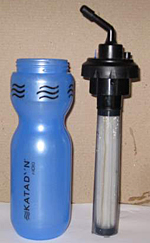 |
Specs: |
Pros: The integrated filter and bottle cap prevents dirty water from flowing around the filter cartridge if the cap is not tightly sealed. Replacement filter is available. Polyethylene bottle is 100-percent BPA free. |
Cons: Opaque bottle makes it difficult to tell how much water is remaining. Lack of a drinking tube cover makes it easy to contaminate, so water must be squirted into mouth and not sucked from tube. Difficult to fully empty last few ounces of water by squeezing the bottle. |
Aquamira Water Bottle with Microbiological Filter |
|||
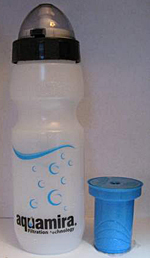 |
Specs: |
Pros: Lexan flip cap protects spout from contaminants. Semi-transparent bottle lets you see how much water remains. Nalgene ATB bottle fits bicycle water bottle cages. Miraguard suppresses the growth of bacteria, algae, fungus, mold, and mildew in the filter between outings. Replacement filter is available. |
Cons: Filter is not attached to the bottle cap, making it easy to accidentally splash unfiltered water on the top of the filter when inserting it after a refill and contaminating output. Water leaks down sides unless bottle cap is tightly sealed and is very difficult to squeeze through filter. |
Bota Outback Water Filtration System |
|||
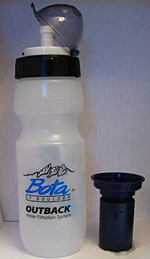 |
Specs: |
Pros: (Note: The Bota and Aquamira bottles use the exact same bottle, spout, and cap.) Lexan flip cap protects spout from contaminants. Semi-transparent bottle lets you see how much water remains. Nalgene ATB bottle fits bicycle water bottle cages. Replacement filter is available. |
Cons: The Bota Outback has the same weaknesses as the Aquamira Water Bottle Filter. Additionally, organic contaminants that have been filtered out by activated carbon filters provide an excellent food source for bacterial growth, particularly when the filter is not used for a long time. |
Aquamira Frontier Pro * Trailspace Pick for Lightweight Backpacking * |
|||
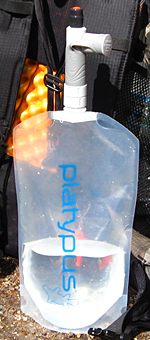 |
Specs: |
Pros: Filter screws onto any used soda bottle or Platypus hydration bladder with 28 mm threads. Protective cap protects bite value from contamination. Polyester, replaceable pre-filter removes sediment, extending the life of the filter. Can be configured as a hands-free gravity filter. Miraguard suppresses the growth of bacteria, algae, fungus, mold, and mildew in the filter between outings. |
Cons: Bite valve can be a little hard on the jaw. Flow rates for the gravity filter configuration vary by filter due to manufacturing differences. Make sure to test at home first. |
|
|
|||
Forthcoming Gear
Two forthcoming in-bottle water treatment options are also worth noting.
 The CamelBak All Clear UV water purification system kit (left) uses ultraviolet technology to neutralize 99.99 percent of bacteria, protozoa, viruses, and other impurities, according to CamelBak. Users fill the bottle, secure the cap, hold the power button down for 4 seconds and rotate the bottle. It will be available in winter/spring 2010. See our OR blog coverage.
The CamelBak All Clear UV water purification system kit (left) uses ultraviolet technology to neutralize 99.99 percent of bacteria, protozoa, viruses, and other impurities, according to CamelBak. Users fill the bottle, secure the cap, hold the power button down for 4 seconds and rotate the bottle. It will be available in winter/spring 2010. See our OR blog coverage.
Katadyn's MyBottle, the only EPA-registered water purifier bottle on the market (right), according to Katadyn, will use three components: Virustat cartridge (to remove viruses and bacteria), a cyst filter (to remove giardia and cryptosporidium), and a carbon pre/post filter (to eliminate odors and improves taste). It will be available as a purifier or microfilter in spring 2010.
The author will test and report on the All Clear and MyBottle once they are available for review.
Share your gear experience with these and other water filters by writing a Trailspace review.

 by Philip Werner
by Philip Werner









